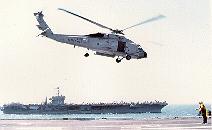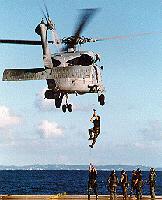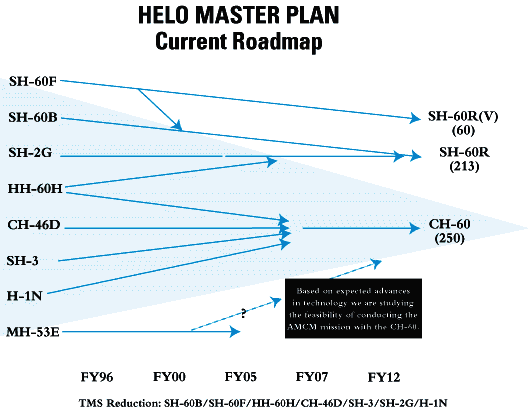THE HELICOPTER MASTER PLAN
 Helicopters are
vital to the execution of numerous Navy missions. The Navy will be "necking
down" to fewer types of helicopters in the future, but rotary-wing requirements
will not lessen.
Helicopters are
vital to the execution of numerous Navy missions. The Navy will be "necking
down" to fewer types of helicopters in the future, but rotary-wing requirements
will not lessen.
The Helicopter Master Plan sets forth the following taskings:
-
Develop a helicopter force structure to meet present and future requirements
until FY 2020 in the antisubmarine warfare, antisurface warfare, mine warfare,
combat search and rescue, special operations, and vertical replenishment
mission areas
-
Reduce costs and infrastructure
-
Make Naval Reserve forces mirror active Navy forces
-
Support air station search and rescue, range support, and other miscellaneous
missions.
The plan calls for expanding warfighting capabilities, modernizing the
force, necking down to three aircraft types, and consolidating force structure
where possible. To meet the new taskings, the Navy is making the changes
described below:
CH-60
The Navy will procure sufficient numbers of CH-60 helicopters to replace
the CH-46D Sea Knight, HH-60H Seahawk, and H-3 Sea King. The CH-60 is the
future aircraft for combat search and rescue, special operations, and logistics
helicopter forces in the Navy. Combining the tested and battle proven U.S.
Army UH-60 Blackhawk fuselage and Navy SH-60 Seahawk dynamic components,
the CH-60 promises to be a superb aircraft. The commonality bred into the
helicopter not only contributes to mission effectiveness, but will provide
logistics and acquisition efficiencies. A CH-60 demonstrator will fly in
the summer of 1997, with full production currently scheduled for FY 1999.
The CH-60 is the linchpin of the Helicopter Master Plan.
SH-60B/F

 The
SH-60B Seahawk is the air component of the LAMPS Mk III weapon system integrated
with the Navy's surface combatant forces. Seahawks have exceeded all Fleet
requirements since their first deployment in 1984. The primary missions
of the Seahawk are antisubmarine warfare and antisurface warfare. It also
supports secondary missions of electronic warfare and command, control,
and communications ‹ as well as the traditional helicopter roles of search
and rescue and logistics. The SH 60F Seahawk, a specialized variant embarked
in aircraft carriers, provides close-in undersea warfare protection to
the battle group. First deployed in 1991, this aircraft is equipped with
active dipping sonar and sonobuoy processing for the ASW mission. The SH-60F
also contributes to maritime interdiction operations, search and rescue
operations, and logistics support.
The
SH-60B Seahawk is the air component of the LAMPS Mk III weapon system integrated
with the Navy's surface combatant forces. Seahawks have exceeded all Fleet
requirements since their first deployment in 1984. The primary missions
of the Seahawk are antisubmarine warfare and antisurface warfare. It also
supports secondary missions of electronic warfare and command, control,
and communications ‹ as well as the traditional helicopter roles of search
and rescue and logistics. The SH 60F Seahawk, a specialized variant embarked
in aircraft carriers, provides close-in undersea warfare protection to
the battle group. First deployed in 1991, this aircraft is equipped with
active dipping sonar and sonobuoy processing for the ASW mission. The SH-60F
also contributes to maritime interdiction operations, search and rescue
operations, and logistics support.
SH-60R
 The conversion of
all SH-60B and SH-60F helicopters to SH-60R or SH 60R(V) will provide a
true multimission helicopter force. The SH-60R upgrade involves the remanufacture
of existing Seahawk variants into an aircraft that will carry the Navy's
tactical helicopter community through 2020. Along with a Service Life Extension
Program for the airframe, the SH-60R will incorporate an advanced multi-mode,
Inverse Synthetic Aperture Radar, the Airborne Low Frequency (dipping)
Sonar, and an upgraded computer suite that will significantly improve the
multimission ability of the SH-60 weapons system.
The conversion of
all SH-60B and SH-60F helicopters to SH-60R or SH 60R(V) will provide a
true multimission helicopter force. The SH-60R upgrade involves the remanufacture
of existing Seahawk variants into an aircraft that will carry the Navy's
tactical helicopter community through 2020. Along with a Service Life Extension
Program for the airframe, the SH-60R will incorporate an advanced multi-mode,
Inverse Synthetic Aperture Radar, the Airborne Low Frequency (dipping)
Sonar, and an upgraded computer suite that will significantly improve the
multimission ability of the SH-60 weapons system.
HH-60H
The HH-60H is also assigned to carrier air wings and performs the missions
of combat search and rescue and special operations warfare support. Capable
of executing either mission from air-capable ships as well as from unprepared
sites ashore, the incorporation of FLIR coupled with Hellfire missiles
and an enhanced survivability package will continue to provide the task
force commander with a potent multimission force multiplier well into the
next century.

Other aspects of the Navy's Helicopter Master Plan include:
-
Outsourcing to employ commercial helicopters and crews to perform logistics
support missions for Military Sealift Command (MSC) ships - if this concept
proves to be operationally and economically feasible. (MSC ships are civilian-manned
and provide logistics support to operational naval forces, as well as point-to-point
transportation for all Department of Defense activities and agencies).
Outsourcing is only one option Naval Aviation is closely examining to ensure
it provides the nation with the most robust force possible given the limited
defense budgets.
-
Consolidating the Helicopter ASW Squadron (HS) and Helicopter Combat Support
Squadron (HC) communities to support aircraft carriers, fast combat support
ships (AOEs), and amphibious ships. AOEs normally operate in direct support
of carrier battle groups. Under this concept, carrier-based helicopter
squadrons will support the AOEs while amphibious ships will be provided
with rescue/utility helicopters from shore-based squadrons. (This is a
separate function from the Marine assault and gunship helicopters that
operate from these amphibious ships).
 System
Overview
System
Overview  Safety
Safety  Affordable
Avionics
Affordable
Avionics  C4/ISR
C4/ISR  Aircraft
Carriers
Aircraft
Carriers  Carrier
Air Wings
Carrier
Air Wings
 F-14
Tomcat
F-14
Tomcat  F/A-18
Hornet
F/A-18
Hornet  Joint
Strike Fighter
Joint
Strike Fighter  Airborne
Reconnaissance Vision
Airborne
Reconnaissance Vision  E-2C
Hawkeye
E-2C
Hawkeye  S-3B
Viking
S-3B
Viking
 ES-3A
Shadow
ES-3A
Shadow  Common
Support Aircraft
Common
Support Aircraft  EA-6B
Prowler
EA-6B
Prowler  Helicopter
Master Plan
Helicopter
Master Plan
 Marine
Corps Fixed-Wing Aircraft
Marine
Corps Fixed-Wing Aircraft  Marine
Corps Rotary-Wing Aircraft
Marine
Corps Rotary-Wing Aircraft  P-3C
Orion
P-3C
Orion  EP-3E
Aries II
EP-3E
Aries II  E-6A/B
Mercury
E-6A/B
Mercury
 Air-to-Air
Missiles
Air-to-Air
Missiles  Air-to-Ground
Weapons
Air-to-Ground
Weapons  Air-to-Subsurface
Weapons
Air-to-Subsurface
Weapons  Naval
Reserve Aviation
Naval
Reserve Aviation  Logistics
Airlift
Logistics
Airlift
 Training
Aircraft
Training
Aircraft  Aircrew
Training
Aircrew
Training  Aviation
Specialized Skills Training
Aviation
Specialized Skills Training  Logistics
Logistics  Expeditionary
Airfields
Expeditionary
Airfields
 Air
Traffic Control
Air
Traffic Control  Ranges
and Airfields
Ranges
and Airfields



 Helicopters are
vital to the execution of numerous Navy missions. The Navy will be "necking
down" to fewer types of helicopters in the future, but rotary-wing requirements
will not lessen.
Helicopters are
vital to the execution of numerous Navy missions. The Navy will be "necking
down" to fewer types of helicopters in the future, but rotary-wing requirements
will not lessen.

 The
SH-60B Seahawk is the air component of the LAMPS Mk III weapon system integrated
with the Navy's surface combatant forces. Seahawks have exceeded all Fleet
requirements since their first deployment in 1984. The primary missions
of the Seahawk are antisubmarine warfare and antisurface warfare. It also
supports secondary missions of electronic warfare and command, control,
and communications ‹ as well as the traditional helicopter roles of search
and rescue and logistics. The SH 60F Seahawk, a specialized variant embarked
in aircraft carriers, provides close-in undersea warfare protection to
the battle group. First deployed in 1991, this aircraft is equipped with
active dipping sonar and sonobuoy processing for the ASW mission. The SH-60F
also contributes to maritime interdiction operations, search and rescue
operations, and logistics support.
The
SH-60B Seahawk is the air component of the LAMPS Mk III weapon system integrated
with the Navy's surface combatant forces. Seahawks have exceeded all Fleet
requirements since their first deployment in 1984. The primary missions
of the Seahawk are antisubmarine warfare and antisurface warfare. It also
supports secondary missions of electronic warfare and command, control,
and communications ‹ as well as the traditional helicopter roles of search
and rescue and logistics. The SH 60F Seahawk, a specialized variant embarked
in aircraft carriers, provides close-in undersea warfare protection to
the battle group. First deployed in 1991, this aircraft is equipped with
active dipping sonar and sonobuoy processing for the ASW mission. The SH-60F
also contributes to maritime interdiction operations, search and rescue
operations, and logistics support.
 The conversion of
all SH-60B and SH-60F helicopters to SH-60R or SH 60R(V) will provide a
true multimission helicopter force. The SH-60R upgrade involves the remanufacture
of existing Seahawk variants into an aircraft that will carry the Navy's
tactical helicopter community through 2020. Along with a Service Life Extension
Program for the airframe, the SH-60R will incorporate an advanced multi-mode,
Inverse Synthetic Aperture Radar, the Airborne Low Frequency (dipping)
Sonar, and an upgraded computer suite that will significantly improve the
multimission ability of the SH-60 weapons system.
The conversion of
all SH-60B and SH-60F helicopters to SH-60R or SH 60R(V) will provide a
true multimission helicopter force. The SH-60R upgrade involves the remanufacture
of existing Seahawk variants into an aircraft that will carry the Navy's
tactical helicopter community through 2020. Along with a Service Life Extension
Program for the airframe, the SH-60R will incorporate an advanced multi-mode,
Inverse Synthetic Aperture Radar, the Airborne Low Frequency (dipping)
Sonar, and an upgraded computer suite that will significantly improve the
multimission ability of the SH-60 weapons system.
